Omar Ahmed Tantawy: Sociology Final Project on Italian Society
VerifiedAdded on 2022/01/17
|14
|3735
|300
Report
AI Summary
This report provides a sociological analysis of Italian society, exploring its social structure, cultural elements, and the impact of the COVID-19 pandemic. It begins with an introduction to Italy, its geography, and population, followed by an examination of the social classes, cultural aspects, and daily life before the pandemic. The report then delves into the impact of COVID-19 on the Italian social structure, including the economy, political landscape, and social movements. It highlights the affected areas, such as physiological and economic crises, and the social construction of everyday life, offering recommendations for future considerations. The report emphasizes the importance of family, social control, and socialization processes within the Italian context, as well as the impact of the pandemic on unemployment and political attitudes. Overall, the report aims to provide a comprehensive overview of the Italian society and its transformation in the face of the COVID-19 pandemic.

[Document title]
[Draw your reader in with an engaging abstract. It is typically a short
summary of the document. When you’re ready to add your content, just
click here and start typing.]
[Document subti tle]
[Draw your reader in with an engaging abstract. It is typically a short
summary of the document. When you’re ready to add your content, just
click here and start typing.]
[Document subti tle]
Paraphrase This Document
Need a fresh take? Get an instant paraphrase of this document with our AI Paraphraser
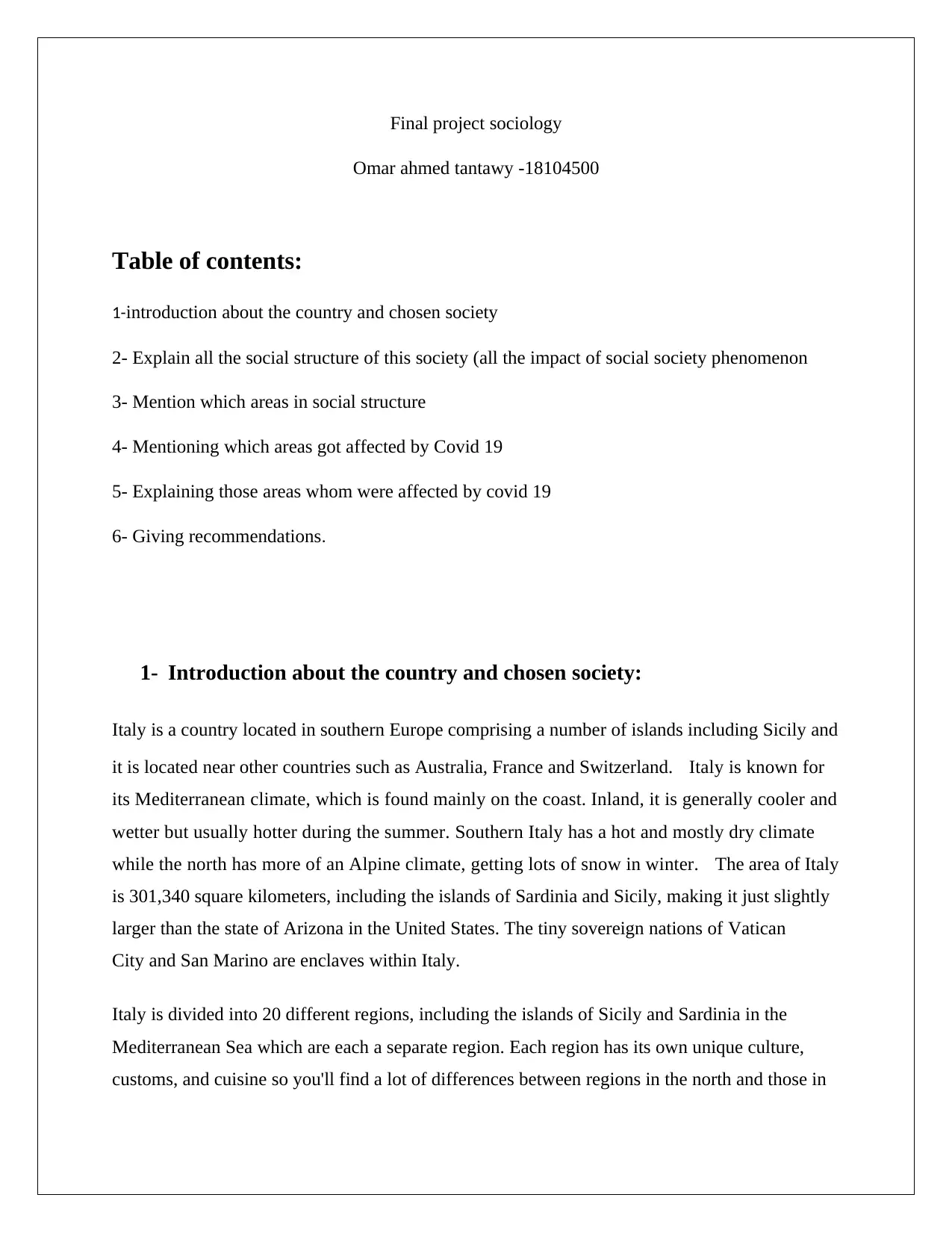
Final project sociology
Omar ahmed tantawy -18104500
Table of contents:
1-introduction about the country and chosen society
2- Explain all the social structure of this society (all the impact of social society phenomenon
3- Mention which areas in social structure
4- Mentioning which areas got affected by Covid 19
5- Explaining those areas whom were affected by covid 19
6- Giving recommendations.
1- Introduction about the country and chosen society:
Italy is a country located in southern Europe comprising a number of islands including Sicily and
it is located near other countries such as Australia, France and Switzerland. Italy is known for
its Mediterranean climate, which is found mainly on the coast. Inland, it is generally cooler and
wetter but usually hotter during the summer. Southern Italy has a hot and mostly dry climate
while the north has more of an Alpine climate, getting lots of snow in winter. The area of Italy
is 301,340 square kilometers, including the islands of Sardinia and Sicily, making it just slightly
larger than the state of Arizona in the United States. The tiny sovereign nations of Vatican
City and San Marino are enclaves within Italy.
Italy is divided into 20 different regions, including the islands of Sicily and Sardinia in the
Mediterranean Sea which are each a separate region. Each region has its own unique culture,
customs, and cuisine so you'll find a lot of differences between regions in the north and those in
Omar ahmed tantawy -18104500
Table of contents:
1-introduction about the country and chosen society
2- Explain all the social structure of this society (all the impact of social society phenomenon
3- Mention which areas in social structure
4- Mentioning which areas got affected by Covid 19
5- Explaining those areas whom were affected by covid 19
6- Giving recommendations.
1- Introduction about the country and chosen society:
Italy is a country located in southern Europe comprising a number of islands including Sicily and
it is located near other countries such as Australia, France and Switzerland. Italy is known for
its Mediterranean climate, which is found mainly on the coast. Inland, it is generally cooler and
wetter but usually hotter during the summer. Southern Italy has a hot and mostly dry climate
while the north has more of an Alpine climate, getting lots of snow in winter. The area of Italy
is 301,340 square kilometers, including the islands of Sardinia and Sicily, making it just slightly
larger than the state of Arizona in the United States. The tiny sovereign nations of Vatican
City and San Marino are enclaves within Italy.
Italy is divided into 20 different regions, including the islands of Sicily and Sardinia in the
Mediterranean Sea which are each a separate region. Each region has its own unique culture,
customs, and cuisine so you'll find a lot of differences between regions in the north and those in
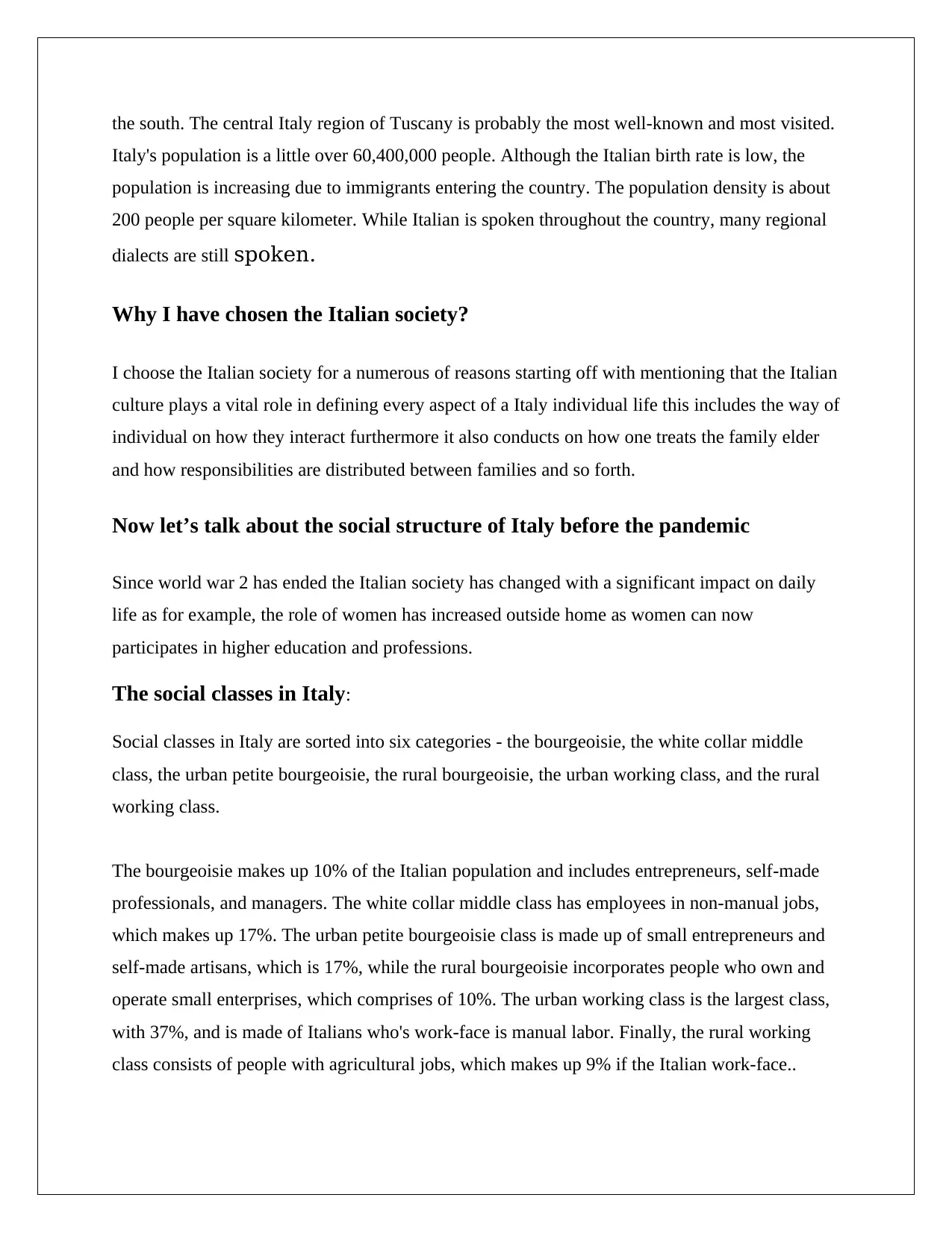
the south. The central Italy region of Tuscany is probably the most well-known and most visited.
Italy's population is a little over 60,400,000 people. Although the Italian birth rate is low, the
population is increasing due to immigrants entering the country. The population density is about
200 people per square kilometer. While Italian is spoken throughout the country, many regional
dialects are still spoken.
Why I have chosen the Italian society?
I choose the Italian society for a numerous of reasons starting off with mentioning that the Italian
culture plays a vital role in defining every aspect of a Italy individual life this includes the way of
individual on how they interact furthermore it also conducts on how one treats the family elder
and how responsibilities are distributed between families and so forth.
Now let’s talk about the social structure of Italy before the pandemic
Since world war 2 has ended the Italian society has changed with a significant impact on daily
life as for example, the role of women has increased outside home as women can now
participates in higher education and professions.
The social classes in Italy:
Social classes in Italy are sorted into six categories - the bourgeoisie, the white collar middle
class, the urban petite bourgeoisie, the rural bourgeoisie, the urban working class, and the rural
working class.
The bourgeoisie makes up 10% of the Italian population and includes entrepreneurs, self-made
professionals, and managers. The white collar middle class has employees in non-manual jobs,
which makes up 17%. The urban petite bourgeoisie class is made up of small entrepreneurs and
self-made artisans, which is 17%, while the rural bourgeoisie incorporates people who own and
operate small enterprises, which comprises of 10%. The urban working class is the largest class,
with 37%, and is made of Italians who's work-face is manual labor. Finally, the rural working
class consists of people with agricultural jobs, which makes up 9% if the Italian work-face..
Italy's population is a little over 60,400,000 people. Although the Italian birth rate is low, the
population is increasing due to immigrants entering the country. The population density is about
200 people per square kilometer. While Italian is spoken throughout the country, many regional
dialects are still spoken.
Why I have chosen the Italian society?
I choose the Italian society for a numerous of reasons starting off with mentioning that the Italian
culture plays a vital role in defining every aspect of a Italy individual life this includes the way of
individual on how they interact furthermore it also conducts on how one treats the family elder
and how responsibilities are distributed between families and so forth.
Now let’s talk about the social structure of Italy before the pandemic
Since world war 2 has ended the Italian society has changed with a significant impact on daily
life as for example, the role of women has increased outside home as women can now
participates in higher education and professions.
The social classes in Italy:
Social classes in Italy are sorted into six categories - the bourgeoisie, the white collar middle
class, the urban petite bourgeoisie, the rural bourgeoisie, the urban working class, and the rural
working class.
The bourgeoisie makes up 10% of the Italian population and includes entrepreneurs, self-made
professionals, and managers. The white collar middle class has employees in non-manual jobs,
which makes up 17%. The urban petite bourgeoisie class is made up of small entrepreneurs and
self-made artisans, which is 17%, while the rural bourgeoisie incorporates people who own and
operate small enterprises, which comprises of 10%. The urban working class is the largest class,
with 37%, and is made of Italians who's work-face is manual labor. Finally, the rural working
class consists of people with agricultural jobs, which makes up 9% if the Italian work-face..
⊘ This is a preview!⊘
Do you want full access?
Subscribe today to unlock all pages.

Trusted by 1+ million students worldwide
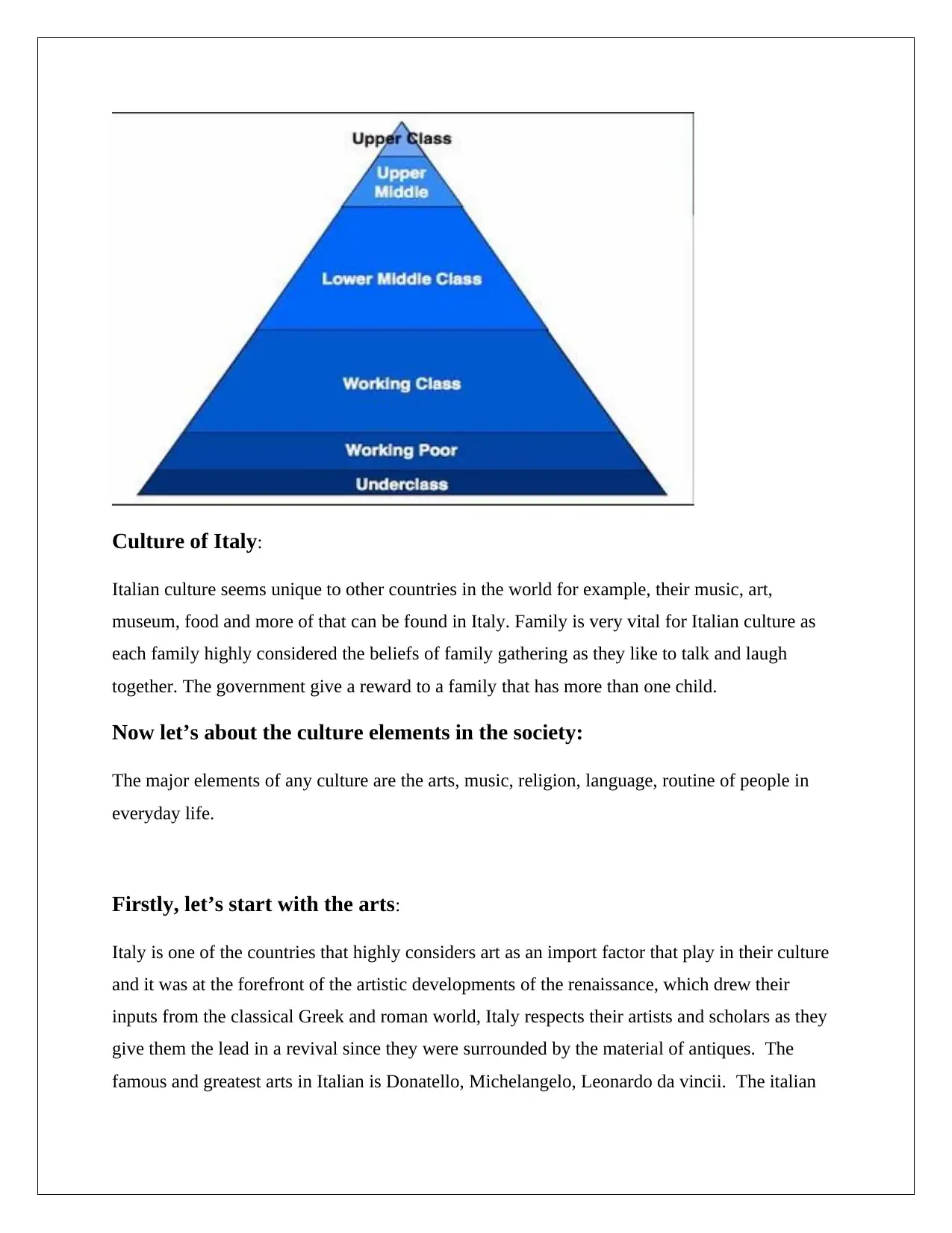
Culture of Italy:
Italian culture seems unique to other countries in the world for example, their music, art,
museum, food and more of that can be found in Italy. Family is very vital for Italian culture as
each family highly considered the beliefs of family gathering as they like to talk and laugh
together. The government give a reward to a family that has more than one child.
Now let’s about the culture elements in the society:
The major elements of any culture are the arts, music, religion, language, routine of people in
everyday life.
Firstly, let’s start with the arts:
Italy is one of the countries that highly considers art as an import factor that play in their culture
and it was at the forefront of the artistic developments of the renaissance, which drew their
inputs from the classical Greek and roman world, Italy respects their artists and scholars as they
give them the lead in a revival since they were surrounded by the material of antiques. The
famous and greatest arts in Italian is Donatello, Michelangelo, Leonardo da vincii. The italian
Italian culture seems unique to other countries in the world for example, their music, art,
museum, food and more of that can be found in Italy. Family is very vital for Italian culture as
each family highly considered the beliefs of family gathering as they like to talk and laugh
together. The government give a reward to a family that has more than one child.
Now let’s about the culture elements in the society:
The major elements of any culture are the arts, music, religion, language, routine of people in
everyday life.
Firstly, let’s start with the arts:
Italy is one of the countries that highly considers art as an import factor that play in their culture
and it was at the forefront of the artistic developments of the renaissance, which drew their
inputs from the classical Greek and roman world, Italy respects their artists and scholars as they
give them the lead in a revival since they were surrounded by the material of antiques. The
famous and greatest arts in Italian is Donatello, Michelangelo, Leonardo da vincii. The italian
Paraphrase This Document
Need a fresh take? Get an instant paraphrase of this document with our AI Paraphraser
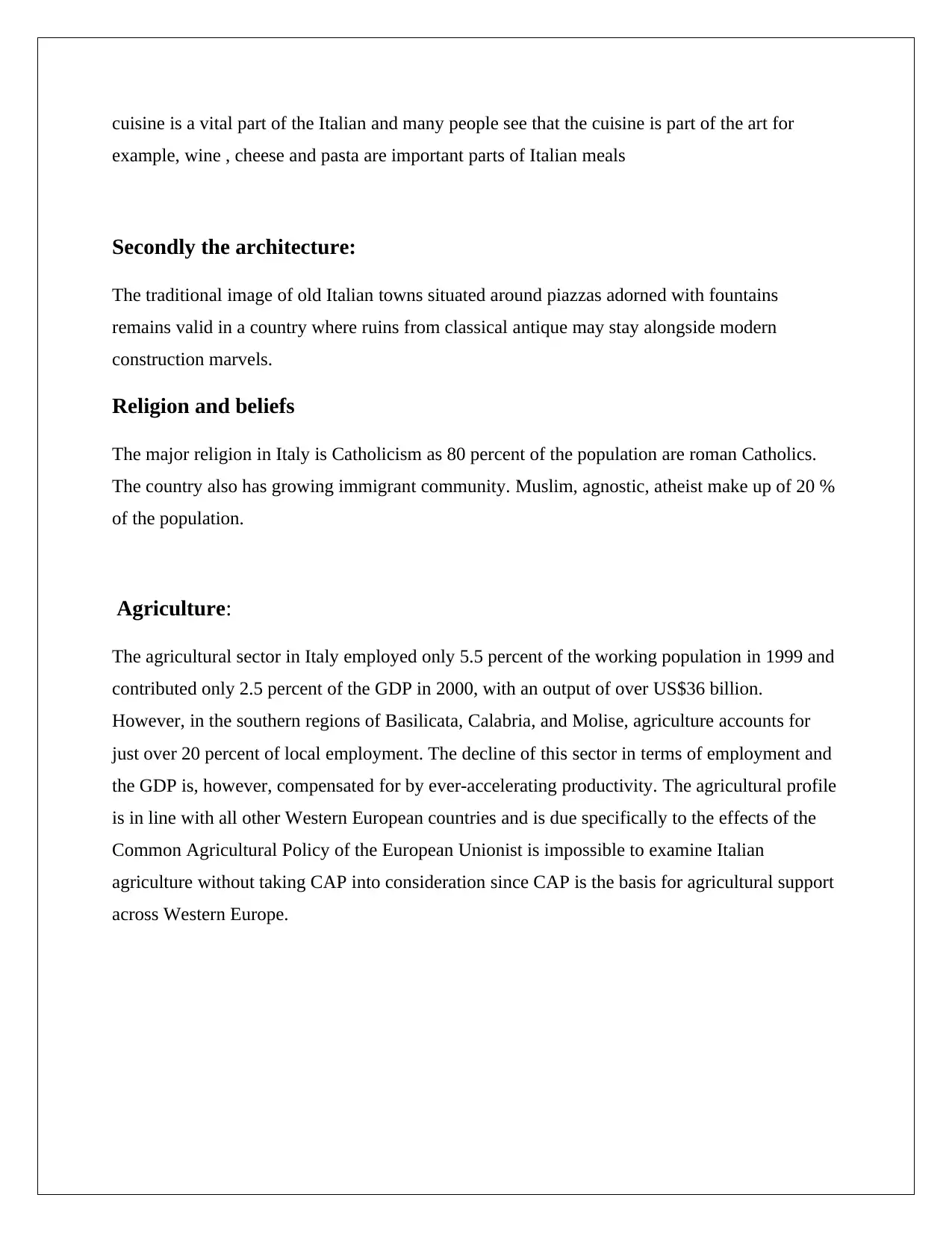
cuisine is a vital part of the Italian and many people see that the cuisine is part of the art for
example, wine , cheese and pasta are important parts of Italian meals
Secondly the architecture:
The traditional image of old Italian towns situated around piazzas adorned with fountains
remains valid in a country where ruins from classical antique may stay alongside modern
construction marvels.
Religion and beliefs
The major religion in Italy is Catholicism as 80 percent of the population are roman Catholics.
The country also has growing immigrant community. Muslim, agnostic, atheist make up of 20 %
of the population.
Agriculture:
The agricultural sector in Italy employed only 5.5 percent of the working population in 1999 and
contributed only 2.5 percent of the GDP in 2000, with an output of over US$36 billion.
However, in the southern regions of Basilicata, Calabria, and Molise, agriculture accounts for
just over 20 percent of local employment. The decline of this sector in terms of employment and
the GDP is, however, compensated for by ever-accelerating productivity. The agricultural profile
is in line with all other Western European countries and is due specifically to the effects of the
Common Agricultural Policy of the European Unionist is impossible to examine Italian
agriculture without taking CAP into consideration since CAP is the basis for agricultural support
across Western Europe.
example, wine , cheese and pasta are important parts of Italian meals
Secondly the architecture:
The traditional image of old Italian towns situated around piazzas adorned with fountains
remains valid in a country where ruins from classical antique may stay alongside modern
construction marvels.
Religion and beliefs
The major religion in Italy is Catholicism as 80 percent of the population are roman Catholics.
The country also has growing immigrant community. Muslim, agnostic, atheist make up of 20 %
of the population.
Agriculture:
The agricultural sector in Italy employed only 5.5 percent of the working population in 1999 and
contributed only 2.5 percent of the GDP in 2000, with an output of over US$36 billion.
However, in the southern regions of Basilicata, Calabria, and Molise, agriculture accounts for
just over 20 percent of local employment. The decline of this sector in terms of employment and
the GDP is, however, compensated for by ever-accelerating productivity. The agricultural profile
is in line with all other Western European countries and is due specifically to the effects of the
Common Agricultural Policy of the European Unionist is impossible to examine Italian
agriculture without taking CAP into consideration since CAP is the basis for agricultural support
across Western Europe.
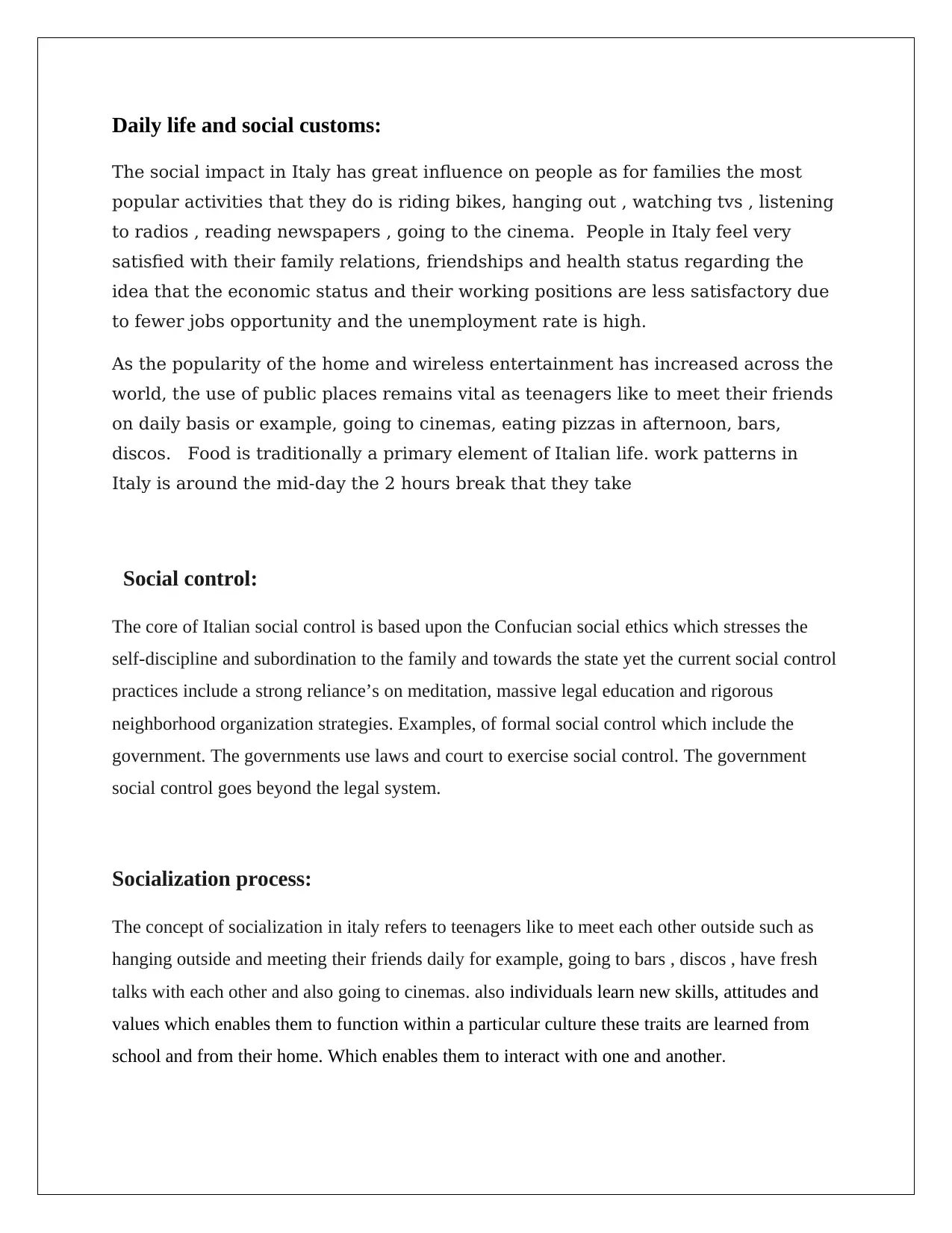
Daily life and social customs:
The social impact in Italy has great influence on people as for families the most
popular activities that they do is riding bikes, hanging out , watching tvs , listening
to radios , reading newspapers , going to the cinema. People in Italy feel very
satisfied with their family relations, friendships and health status regarding the
idea that the economic status and their working positions are less satisfactory due
to fewer jobs opportunity and the unemployment rate is high.
As the popularity of the home and wireless entertainment has increased across the
world, the use of public places remains vital as teenagers like to meet their friends
on daily basis or example, going to cinemas, eating pizzas in afternoon, bars,
discos. Food is traditionally a primary element of Italian life. work patterns in
Italy is around the mid-day the 2 hours break that they take
Social control:
The core of Italian social control is based upon the Confucian social ethics which stresses the
self-discipline and subordination to the family and towards the state yet the current social control
practices include a strong reliance’s on meditation, massive legal education and rigorous
neighborhood organization strategies. Examples, of formal social control which include the
government. The governments use laws and court to exercise social control. The government
social control goes beyond the legal system.
Socialization process:
The concept of socialization in italy refers to teenagers like to meet each other outside such as
hanging outside and meeting their friends daily for example, going to bars , discos , have fresh
talks with each other and also going to cinemas. also individuals learn new skills, attitudes and
values which enables them to function within a particular culture these traits are learned from
school and from their home. Which enables them to interact with one and another.
The social impact in Italy has great influence on people as for families the most
popular activities that they do is riding bikes, hanging out , watching tvs , listening
to radios , reading newspapers , going to the cinema. People in Italy feel very
satisfied with their family relations, friendships and health status regarding the
idea that the economic status and their working positions are less satisfactory due
to fewer jobs opportunity and the unemployment rate is high.
As the popularity of the home and wireless entertainment has increased across the
world, the use of public places remains vital as teenagers like to meet their friends
on daily basis or example, going to cinemas, eating pizzas in afternoon, bars,
discos. Food is traditionally a primary element of Italian life. work patterns in
Italy is around the mid-day the 2 hours break that they take
Social control:
The core of Italian social control is based upon the Confucian social ethics which stresses the
self-discipline and subordination to the family and towards the state yet the current social control
practices include a strong reliance’s on meditation, massive legal education and rigorous
neighborhood organization strategies. Examples, of formal social control which include the
government. The governments use laws and court to exercise social control. The government
social control goes beyond the legal system.
Socialization process:
The concept of socialization in italy refers to teenagers like to meet each other outside such as
hanging outside and meeting their friends daily for example, going to bars , discos , have fresh
talks with each other and also going to cinemas. also individuals learn new skills, attitudes and
values which enables them to function within a particular culture these traits are learned from
school and from their home. Which enables them to interact with one and another.
⊘ This is a preview!⊘
Do you want full access?
Subscribe today to unlock all pages.

Trusted by 1+ million students worldwide
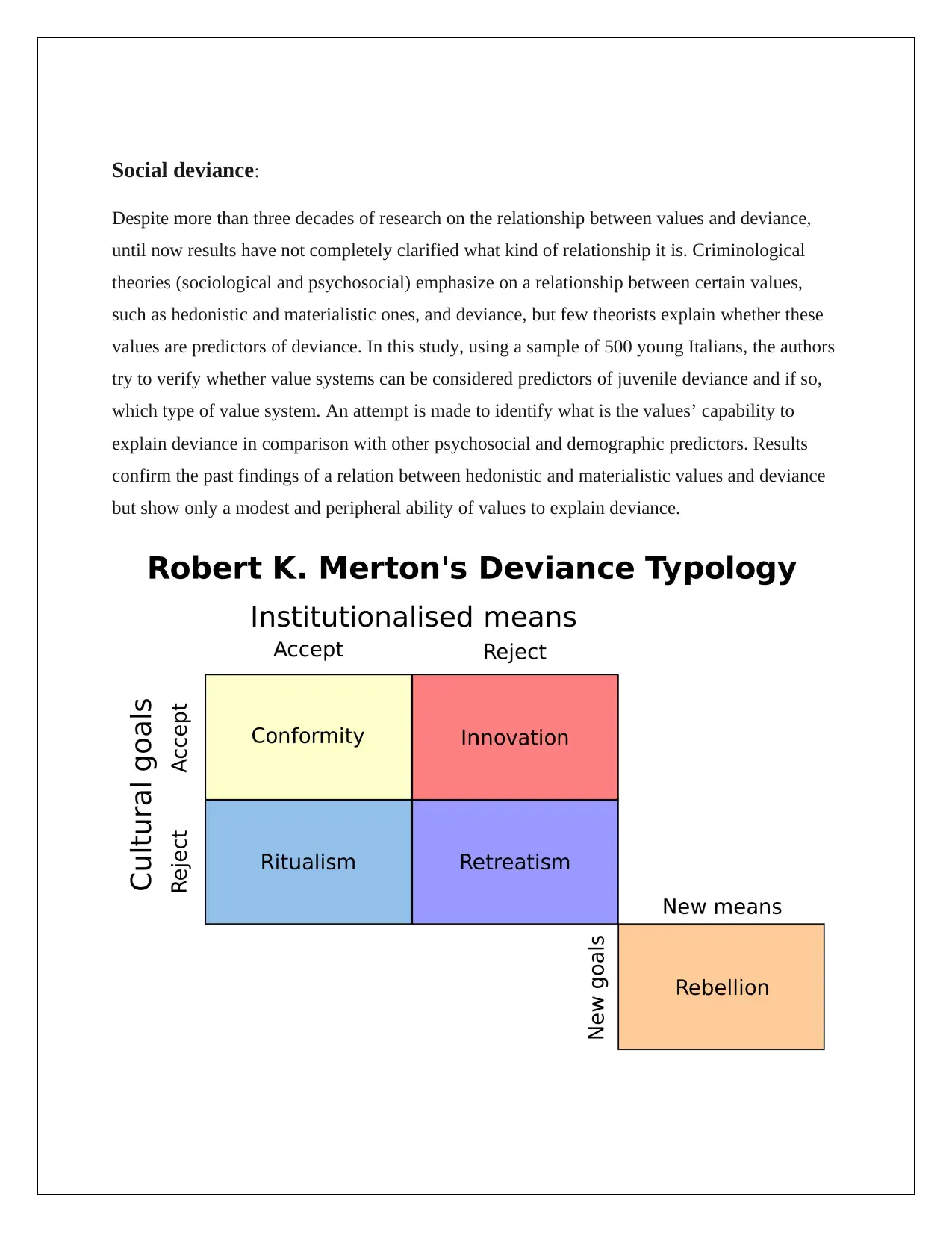
Social deviance:
Despite more than three decades of research on the relationship between values and deviance,
until now results have not completely clarified what kind of relationship it is. Criminological
theories (sociological and psychosocial) emphasize on a relationship between certain values,
such as hedonistic and materialistic ones, and deviance, but few theorists explain whether these
values are predictors of deviance. In this study, using a sample of 500 young Italians, the authors
try to verify whether value systems can be considered predictors of juvenile deviance and if so,
which type of value system. An attempt is made to identify what is the values’ capability to
explain deviance in comparison with other psychosocial and demographic predictors. Results
confirm the past findings of a relation between hedonistic and materialistic values and deviance
but show only a modest and peripheral ability of values to explain deviance.
Despite more than three decades of research on the relationship between values and deviance,
until now results have not completely clarified what kind of relationship it is. Criminological
theories (sociological and psychosocial) emphasize on a relationship between certain values,
such as hedonistic and materialistic ones, and deviance, but few theorists explain whether these
values are predictors of deviance. In this study, using a sample of 500 young Italians, the authors
try to verify whether value systems can be considered predictors of juvenile deviance and if so,
which type of value system. An attempt is made to identify what is the values’ capability to
explain deviance in comparison with other psychosocial and demographic predictors. Results
confirm the past findings of a relation between hedonistic and materialistic values and deviance
but show only a modest and peripheral ability of values to explain deviance.
Paraphrase This Document
Need a fresh take? Get an instant paraphrase of this document with our AI Paraphraser
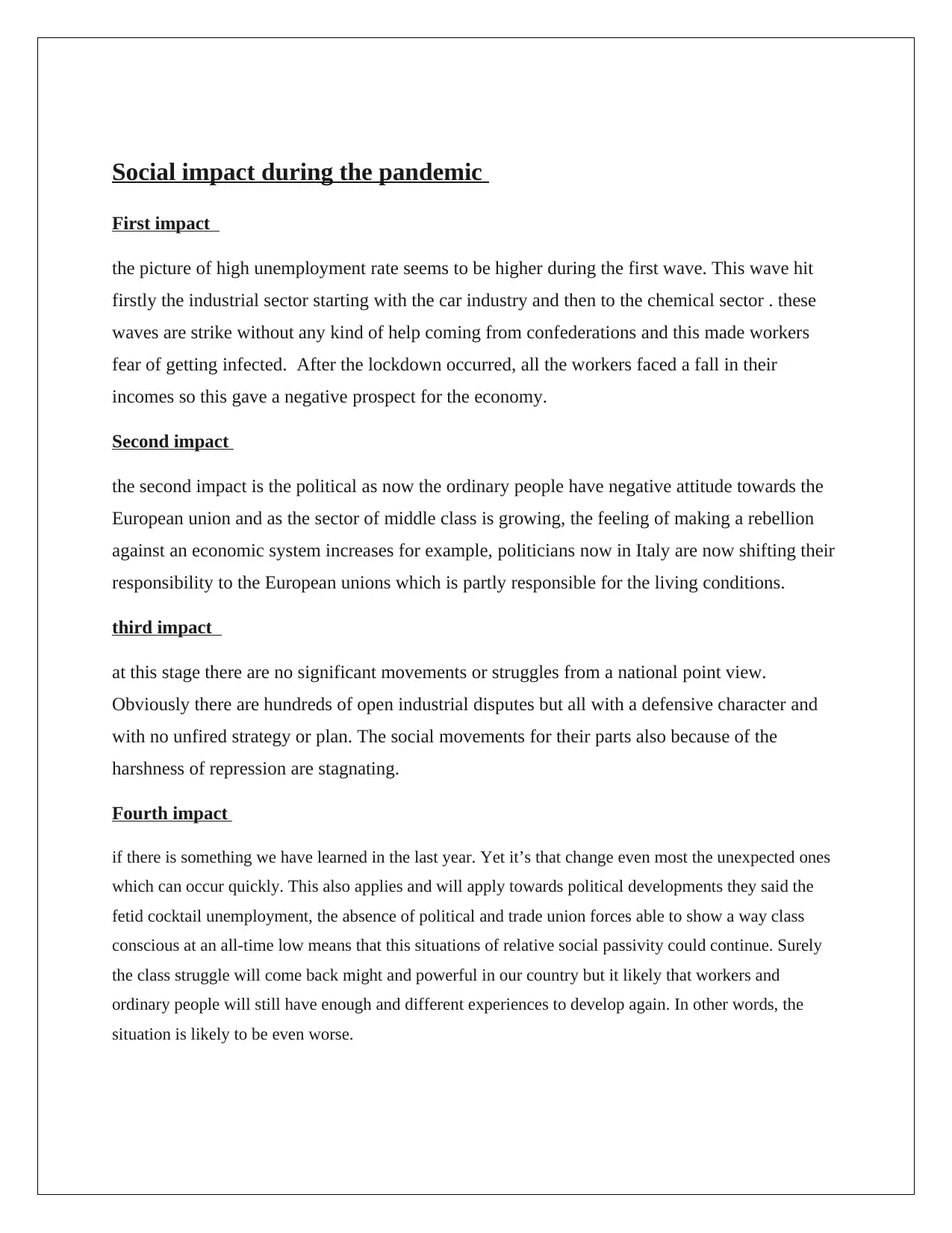
Social impact during the pandemic
First impact
the picture of high unemployment rate seems to be higher during the first wave. This wave hit
firstly the industrial sector starting with the car industry and then to the chemical sector . these
waves are strike without any kind of help coming from confederations and this made workers
fear of getting infected. After the lockdown occurred, all the workers faced a fall in their
incomes so this gave a negative prospect for the economy.
Second impact
the second impact is the political as now the ordinary people have negative attitude towards the
European union and as the sector of middle class is growing, the feeling of making a rebellion
against an economic system increases for example, politicians now in Italy are now shifting their
responsibility to the European unions which is partly responsible for the living conditions.
third impact
at this stage there are no significant movements or struggles from a national point view.
Obviously there are hundreds of open industrial disputes but all with a defensive character and
with no unfired strategy or plan. The social movements for their parts also because of the
harshness of repression are stagnating.
Fourth impact
if there is something we have learned in the last year. Yet it’s that change even most the unexpected ones
which can occur quickly. This also applies and will apply towards political developments they said the
fetid cocktail unemployment, the absence of political and trade union forces able to show a way class
conscious at an all-time low means that this situations of relative social passivity could continue. Surely
the class struggle will come back might and powerful in our country but it likely that workers and
ordinary people will still have enough and different experiences to develop again. In other words, the
situation is likely to be even worse.
First impact
the picture of high unemployment rate seems to be higher during the first wave. This wave hit
firstly the industrial sector starting with the car industry and then to the chemical sector . these
waves are strike without any kind of help coming from confederations and this made workers
fear of getting infected. After the lockdown occurred, all the workers faced a fall in their
incomes so this gave a negative prospect for the economy.
Second impact
the second impact is the political as now the ordinary people have negative attitude towards the
European union and as the sector of middle class is growing, the feeling of making a rebellion
against an economic system increases for example, politicians now in Italy are now shifting their
responsibility to the European unions which is partly responsible for the living conditions.
third impact
at this stage there are no significant movements or struggles from a national point view.
Obviously there are hundreds of open industrial disputes but all with a defensive character and
with no unfired strategy or plan. The social movements for their parts also because of the
harshness of repression are stagnating.
Fourth impact
if there is something we have learned in the last year. Yet it’s that change even most the unexpected ones
which can occur quickly. This also applies and will apply towards political developments they said the
fetid cocktail unemployment, the absence of political and trade union forces able to show a way class
conscious at an all-time low means that this situations of relative social passivity could continue. Surely
the class struggle will come back might and powerful in our country but it likely that workers and
ordinary people will still have enough and different experiences to develop again. In other words, the
situation is likely to be even worse.
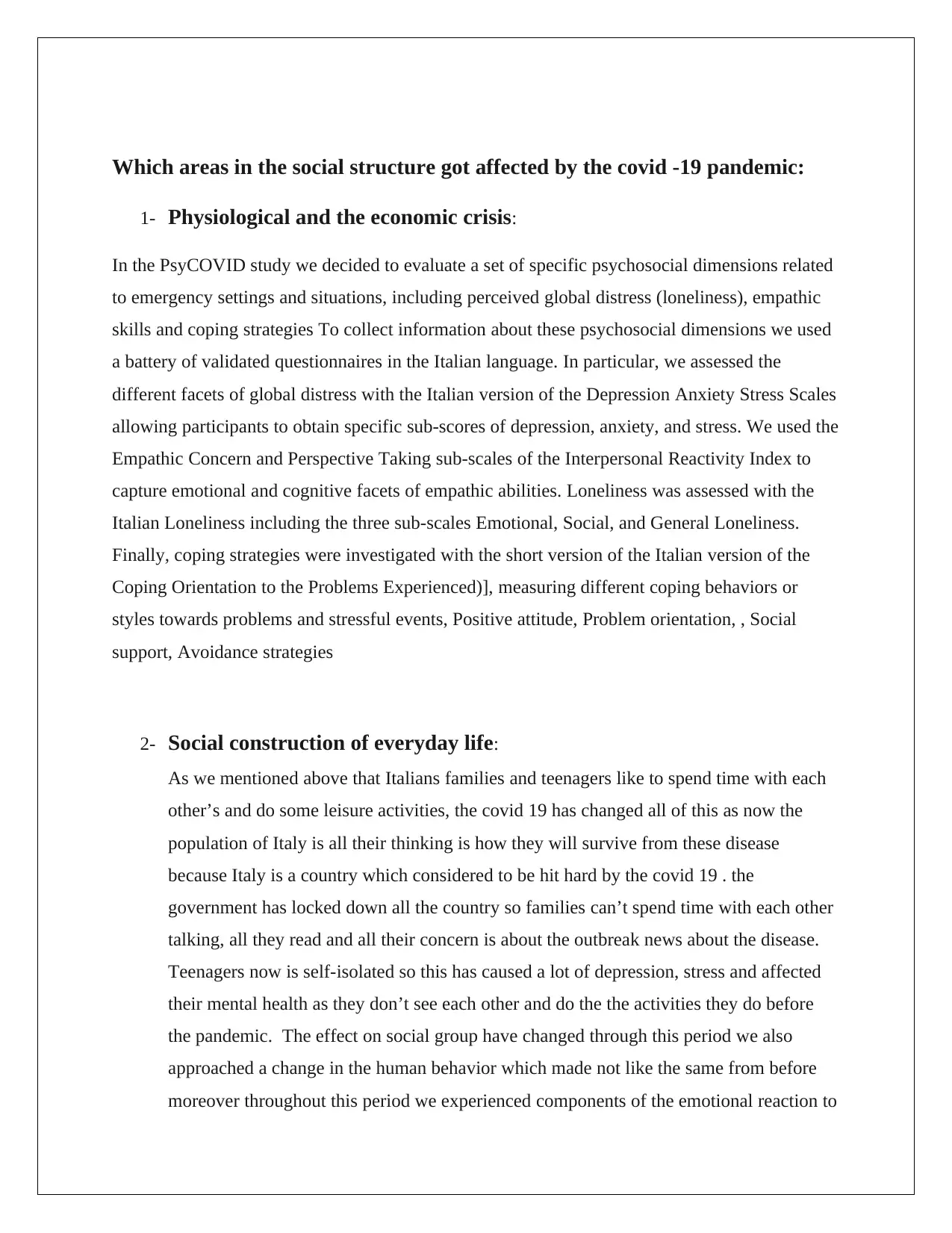
Which areas in the social structure got affected by the covid -19 pandemic:
1- Physiological and the economic crisis:
In the PsyCOVID study we decided to evaluate a set of specific psychosocial dimensions related
to emergency settings and situations, including perceived global distress (loneliness), empathic
skills and coping strategies To collect information about these psychosocial dimensions we used
a battery of validated questionnaires in the Italian language. In particular, we assessed the
different facets of global distress with the Italian version of the Depression Anxiety Stress Scales
allowing participants to obtain specific sub-scores of depression, anxiety, and stress. We used the
Empathic Concern and Perspective Taking sub-scales of the Interpersonal Reactivity Index to
capture emotional and cognitive facets of empathic abilities. Loneliness was assessed with the
Italian Loneliness including the three sub-scales Emotional, Social, and General Loneliness.
Finally, coping strategies were investigated with the short version of the Italian version of the
Coping Orientation to the Problems Experienced)], measuring different coping behaviors or
styles towards problems and stressful events, Positive attitude, Problem orientation, , Social
support, Avoidance strategies
2- Social construction of everyday life:
As we mentioned above that Italians families and teenagers like to spend time with each
other’s and do some leisure activities, the covid 19 has changed all of this as now the
population of Italy is all their thinking is how they will survive from these disease
because Italy is a country which considered to be hit hard by the covid 19 . the
government has locked down all the country so families can’t spend time with each other
talking, all they read and all their concern is about the outbreak news about the disease.
Teenagers now is self-isolated so this has caused a lot of depression, stress and affected
their mental health as they don’t see each other and do the the activities they do before
the pandemic. The effect on social group have changed through this period we also
approached a change in the human behavior which made not like the same from before
moreover throughout this period we experienced components of the emotional reaction to
1- Physiological and the economic crisis:
In the PsyCOVID study we decided to evaluate a set of specific psychosocial dimensions related
to emergency settings and situations, including perceived global distress (loneliness), empathic
skills and coping strategies To collect information about these psychosocial dimensions we used
a battery of validated questionnaires in the Italian language. In particular, we assessed the
different facets of global distress with the Italian version of the Depression Anxiety Stress Scales
allowing participants to obtain specific sub-scores of depression, anxiety, and stress. We used the
Empathic Concern and Perspective Taking sub-scales of the Interpersonal Reactivity Index to
capture emotional and cognitive facets of empathic abilities. Loneliness was assessed with the
Italian Loneliness including the three sub-scales Emotional, Social, and General Loneliness.
Finally, coping strategies were investigated with the short version of the Italian version of the
Coping Orientation to the Problems Experienced)], measuring different coping behaviors or
styles towards problems and stressful events, Positive attitude, Problem orientation, , Social
support, Avoidance strategies
2- Social construction of everyday life:
As we mentioned above that Italians families and teenagers like to spend time with each
other’s and do some leisure activities, the covid 19 has changed all of this as now the
population of Italy is all their thinking is how they will survive from these disease
because Italy is a country which considered to be hit hard by the covid 19 . the
government has locked down all the country so families can’t spend time with each other
talking, all they read and all their concern is about the outbreak news about the disease.
Teenagers now is self-isolated so this has caused a lot of depression, stress and affected
their mental health as they don’t see each other and do the the activities they do before
the pandemic. The effect on social group have changed through this period we also
approached a change in the human behavior which made not like the same from before
moreover throughout this period we experienced components of the emotional reaction to
⊘ This is a preview!⊘
Do you want full access?
Subscribe today to unlock all pages.

Trusted by 1+ million students worldwide
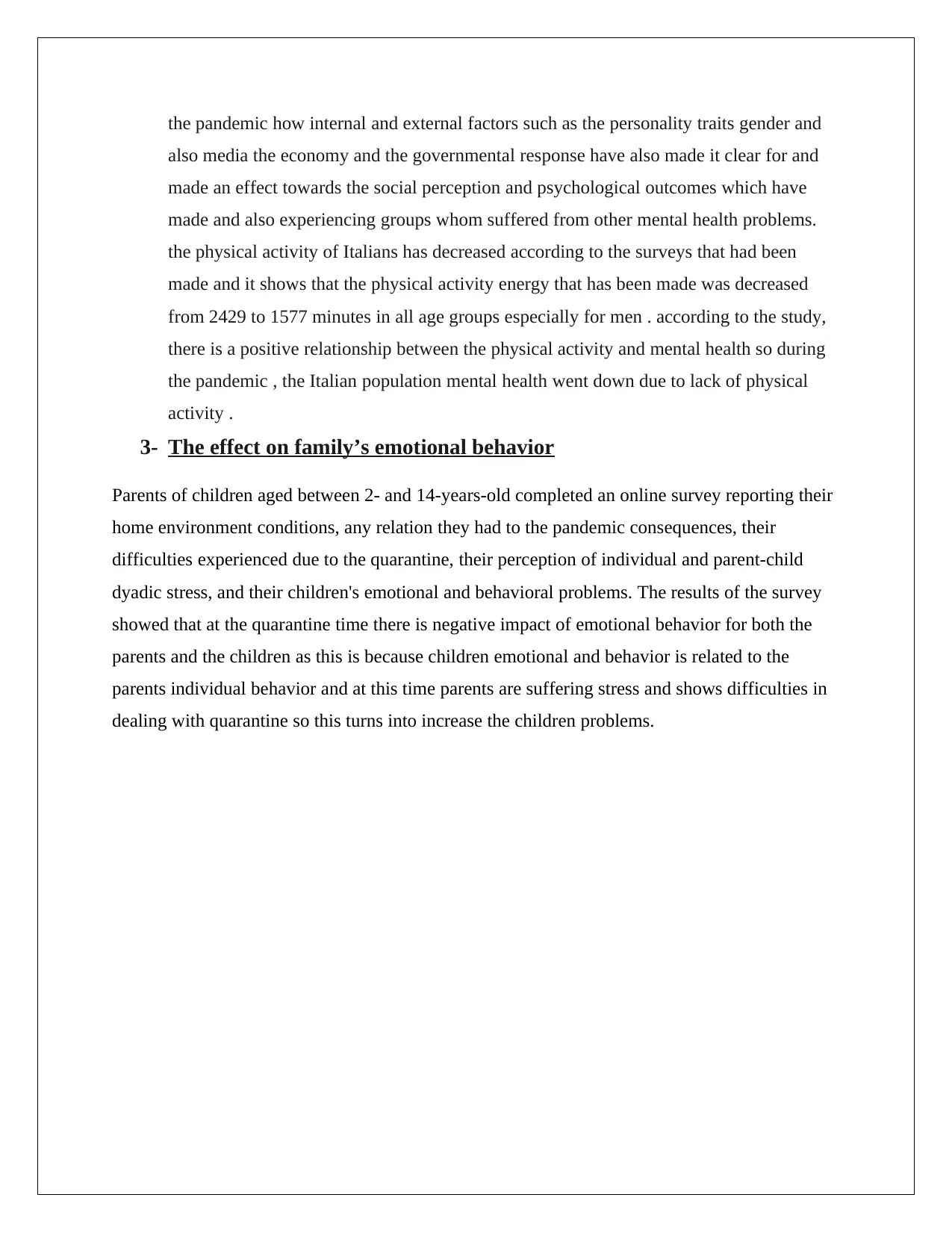
the pandemic how internal and external factors such as the personality traits gender and
also media the economy and the governmental response have also made it clear for and
made an effect towards the social perception and psychological outcomes which have
made and also experiencing groups whom suffered from other mental health problems.
the physical activity of Italians has decreased according to the surveys that had been
made and it shows that the physical activity energy that has been made was decreased
from 2429 to 1577 minutes in all age groups especially for men . according to the study,
there is a positive relationship between the physical activity and mental health so during
the pandemic , the Italian population mental health went down due to lack of physical
activity .
3- The effect on family’s emotional behavior
Parents of children aged between 2- and 14-years-old completed an online survey reporting their
home environment conditions, any relation they had to the pandemic consequences, their
difficulties experienced due to the quarantine, their perception of individual and parent-child
dyadic stress, and their children's emotional and behavioral problems. The results of the survey
showed that at the quarantine time there is negative impact of emotional behavior for both the
parents and the children as this is because children emotional and behavior is related to the
parents individual behavior and at this time parents are suffering stress and shows difficulties in
dealing with quarantine so this turns into increase the children problems.
also media the economy and the governmental response have also made it clear for and
made an effect towards the social perception and psychological outcomes which have
made and also experiencing groups whom suffered from other mental health problems.
the physical activity of Italians has decreased according to the surveys that had been
made and it shows that the physical activity energy that has been made was decreased
from 2429 to 1577 minutes in all age groups especially for men . according to the study,
there is a positive relationship between the physical activity and mental health so during
the pandemic , the Italian population mental health went down due to lack of physical
activity .
3- The effect on family’s emotional behavior
Parents of children aged between 2- and 14-years-old completed an online survey reporting their
home environment conditions, any relation they had to the pandemic consequences, their
difficulties experienced due to the quarantine, their perception of individual and parent-child
dyadic stress, and their children's emotional and behavioral problems. The results of the survey
showed that at the quarantine time there is negative impact of emotional behavior for both the
parents and the children as this is because children emotional and behavior is related to the
parents individual behavior and at this time parents are suffering stress and shows difficulties in
dealing with quarantine so this turns into increase the children problems.
Paraphrase This Document
Need a fresh take? Get an instant paraphrase of this document with our AI Paraphraser
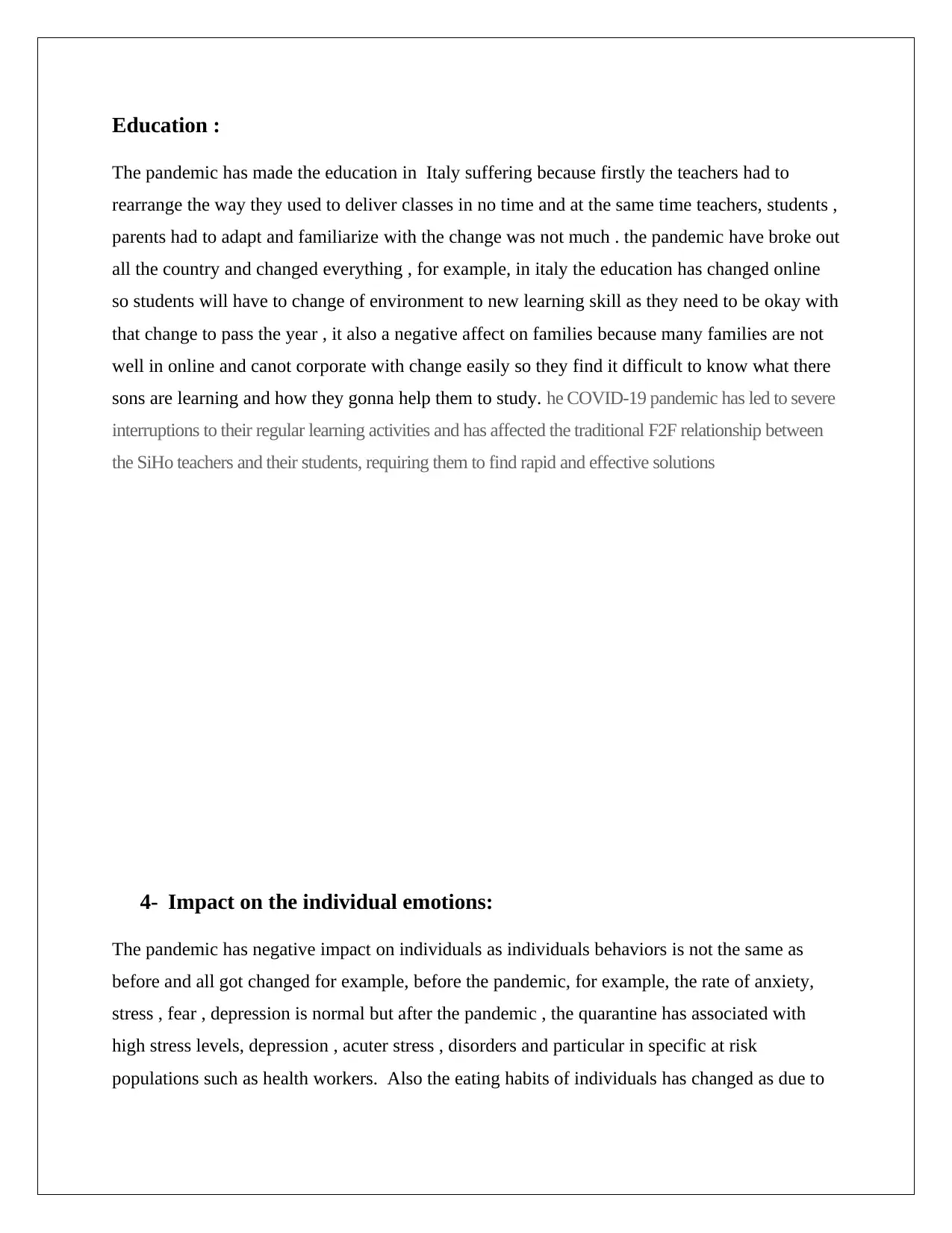
Education :
The pandemic has made the education in Italy suffering because firstly the teachers had to
rearrange the way they used to deliver classes in no time and at the same time teachers, students ,
parents had to adapt and familiarize with the change was not much . the pandemic have broke out
all the country and changed everything , for example, in italy the education has changed online
so students will have to change of environment to new learning skill as they need to be okay with
that change to pass the year , it also a negative affect on families because many families are not
well in online and canot corporate with change easily so they find it difficult to know what there
sons are learning and how they gonna help them to study. he COVID-19 pandemic has led to severe
interruptions to their regular learning activities and has affected the traditional F2F relationship between
the SiHo teachers and their students, requiring them to find rapid and effective solutions
4- Impact on the individual emotions:
The pandemic has negative impact on individuals as individuals behaviors is not the same as
before and all got changed for example, before the pandemic, for example, the rate of anxiety,
stress , fear , depression is normal but after the pandemic , the quarantine has associated with
high stress levels, depression , acuter stress , disorders and particular in specific at risk
populations such as health workers. Also the eating habits of individuals has changed as due to
The pandemic has made the education in Italy suffering because firstly the teachers had to
rearrange the way they used to deliver classes in no time and at the same time teachers, students ,
parents had to adapt and familiarize with the change was not much . the pandemic have broke out
all the country and changed everything , for example, in italy the education has changed online
so students will have to change of environment to new learning skill as they need to be okay with
that change to pass the year , it also a negative affect on families because many families are not
well in online and canot corporate with change easily so they find it difficult to know what there
sons are learning and how they gonna help them to study. he COVID-19 pandemic has led to severe
interruptions to their regular learning activities and has affected the traditional F2F relationship between
the SiHo teachers and their students, requiring them to find rapid and effective solutions
4- Impact on the individual emotions:
The pandemic has negative impact on individuals as individuals behaviors is not the same as
before and all got changed for example, before the pandemic, for example, the rate of anxiety,
stress , fear , depression is normal but after the pandemic , the quarantine has associated with
high stress levels, depression , acuter stress , disorders and particular in specific at risk
populations such as health workers. Also the eating habits of individuals has changed as due to
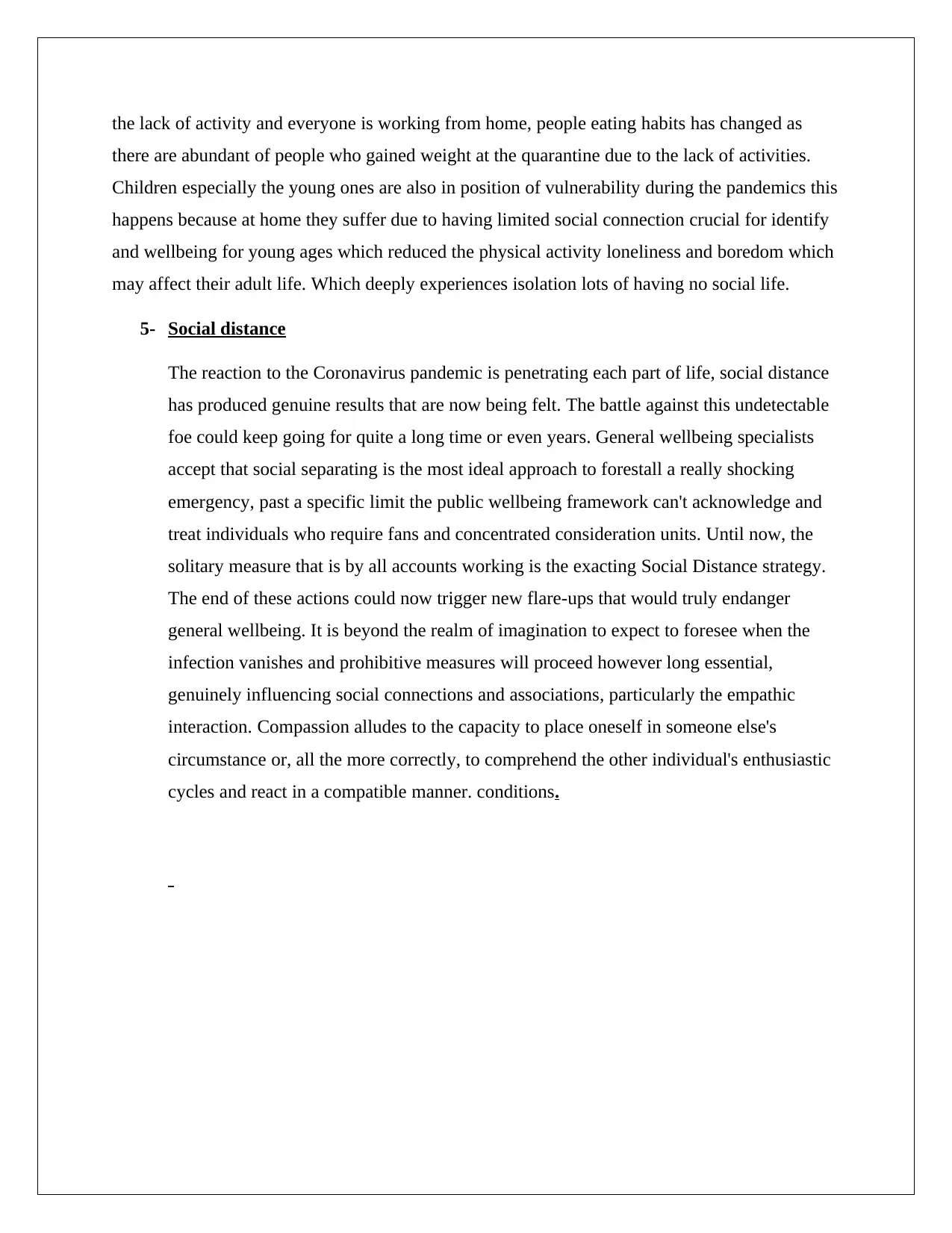
the lack of activity and everyone is working from home, people eating habits has changed as
there are abundant of people who gained weight at the quarantine due to the lack of activities.
Children especially the young ones are also in position of vulnerability during the pandemics this
happens because at home they suffer due to having limited social connection crucial for identify
and wellbeing for young ages which reduced the physical activity loneliness and boredom which
may affect their adult life. Which deeply experiences isolation lots of having no social life.
5- Social distance
The reaction to the Coronavirus pandemic is penetrating each part of life, social distance
has produced genuine results that are now being felt. The battle against this undetectable
foe could keep going for quite a long time or even years. General wellbeing specialists
accept that social separating is the most ideal approach to forestall a really shocking
emergency, past a specific limit the public wellbeing framework can't acknowledge and
treat individuals who require fans and concentrated consideration units. Until now, the
solitary measure that is by all accounts working is the exacting Social Distance strategy.
The end of these actions could now trigger new flare-ups that would truly endanger
general wellbeing. It is beyond the realm of imagination to expect to foresee when the
infection vanishes and prohibitive measures will proceed however long essential,
genuinely influencing social connections and associations, particularly the empathic
interaction. Compassion alludes to the capacity to place oneself in someone else's
circumstance or, all the more correctly, to comprehend the other individual's enthusiastic
cycles and react in a compatible manner. conditions.
there are abundant of people who gained weight at the quarantine due to the lack of activities.
Children especially the young ones are also in position of vulnerability during the pandemics this
happens because at home they suffer due to having limited social connection crucial for identify
and wellbeing for young ages which reduced the physical activity loneliness and boredom which
may affect their adult life. Which deeply experiences isolation lots of having no social life.
5- Social distance
The reaction to the Coronavirus pandemic is penetrating each part of life, social distance
has produced genuine results that are now being felt. The battle against this undetectable
foe could keep going for quite a long time or even years. General wellbeing specialists
accept that social separating is the most ideal approach to forestall a really shocking
emergency, past a specific limit the public wellbeing framework can't acknowledge and
treat individuals who require fans and concentrated consideration units. Until now, the
solitary measure that is by all accounts working is the exacting Social Distance strategy.
The end of these actions could now trigger new flare-ups that would truly endanger
general wellbeing. It is beyond the realm of imagination to expect to foresee when the
infection vanishes and prohibitive measures will proceed however long essential,
genuinely influencing social connections and associations, particularly the empathic
interaction. Compassion alludes to the capacity to place oneself in someone else's
circumstance or, all the more correctly, to comprehend the other individual's enthusiastic
cycles and react in a compatible manner. conditions.
⊘ This is a preview!⊘
Do you want full access?
Subscribe today to unlock all pages.

Trusted by 1+ million students worldwide
1 out of 14
Your All-in-One AI-Powered Toolkit for Academic Success.
+13062052269
info@desklib.com
Available 24*7 on WhatsApp / Email
![[object Object]](/_next/static/media/star-bottom.7253800d.svg)
Unlock your academic potential
Copyright © 2020–2025 A2Z Services. All Rights Reserved. Developed and managed by ZUCOL.